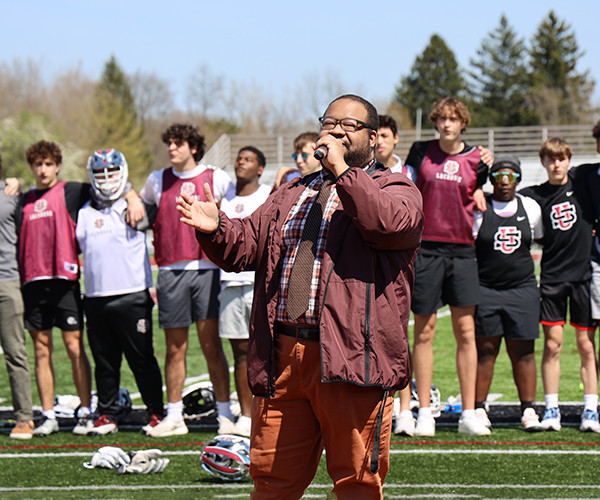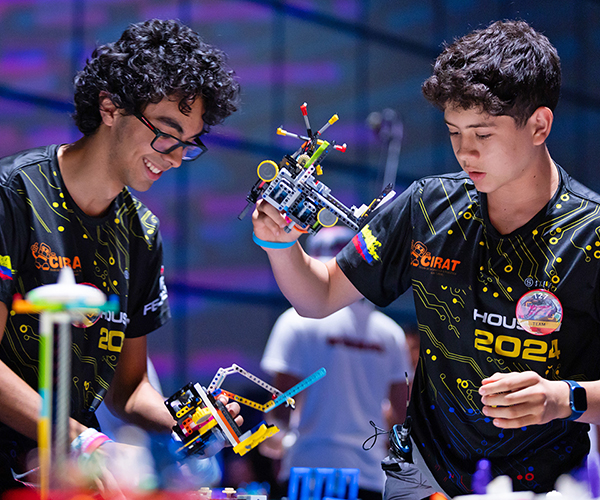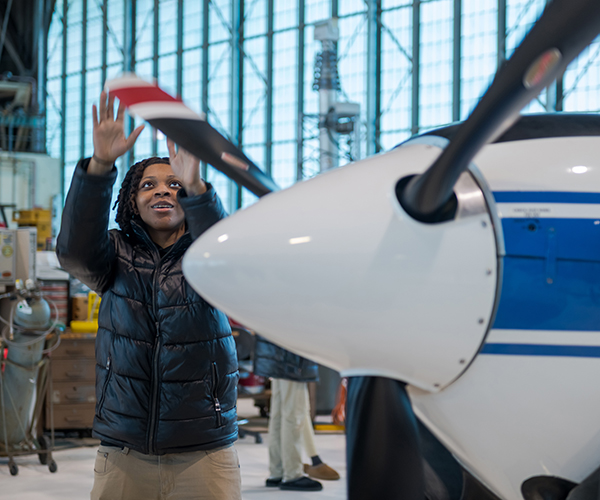Welcome to the Real World
Schools are extending their reach by taking the classroom to the world — constructing chicken coops for a Tanzanian orphanage, giving mini-loans to grocers in the Dominican Republic and rebuilding a school in Nicaragua.
When the Laurel girls walked through the church door that housed the Alfayo preschool, the children were dancing and smiling in a small, stark room that contained only benches.
There were no toys, crayons, coloring books or brightly colored posters like in U.S. preschools. The only primary-colored items were the children’s red, green and blue porridge cups. For many, it was their only meal of the day.
“Despite their poor living conditions and challenges they faced, they were enjoying every moment to the fullest,” says Reese, a senior at Laurel School in Shaker Heights.
That image, she says, will stay with her forever.
The 10-day trip made its mark on Tanzania as well. Fifteen Laurel students painted the Alfayo’s administrative building and built a chicken coop that had been designed in a Laurel engineering class.
“Coming from a small private school in Shaker Heights, we never really get to understand the world outside of our school walls aside from the newspaper and CNN,” she says. “But when you travel to places like Tanzania, you really feel like you are an important part of making the world a better place, one person at a time.”
While schools have traditionally served their local communities, there’s a push by many independent schools to reach out with international projects that teach students lessons ranging from teamwork to global awareness to economics.
“Opportunities to study abroad, attend classes with students from a variety of cultures — whether exchange students or boarders — and select from a larger array of second language classes are all on the increase within the [Cleveland Council of Independent Schools],” says Linda Alexander, the group’s executive director. “We recognize that global awareness is a 21st century life-skill, as is learning to work collaboratively with individuals representing diverse cultures, religions, lifestyles.”
In fact, the new Cleveland Council of Independent Schools’ Web site includes a link to service opportunities in Northeast Ohio and throughout the world.
During his campaign, President Barack Obama pushed to make 50 hours of community service mandatory for middle and high school students. Some places already require it, with Maryland demanding 75 hours and the District of Columbia asking for 100 hours from students.
While it’s tough to find statistics exclusive to middle or high school students, Volunteering in America says that 8.24 million young people ages 16 to 24 volunteered in 2008, up by 441,000.
Among large cities, Cleveland ranked 26th, behind Cincinnati (7) and Columbus (17), with a 22 percent volunteer rate among the same age group.
At Laurel School, the project wrapped service, engineering and the real world into one powerful educational package.
Their efforts supported the Olevolos Project, a nonprofit organization founded by former Laurel English teacher Dory Gannes which helps children in Olevolos Village.
Gannes asked the girls in Laurel’s Principles of Engineering class to design a chicken coop for the Olevolos orphanage, while the group of girls making the trip to Tanzania would build it.
“Having a chicken coop on the orphanage property would give the orphans a steady protein source,” explains Licia Kovach, chair of Laurel’s science department and the engineering class teacher. “And the orphanage would have a source of income from the sale of eggs at the local market.”
The students had to work out real-world challenges that often won’t arise in an engineering class, where projects never get built. The girls consulted a local civil engineer and used Skype to talk to the orphanage director in Tanzania about the square footage required per chicken for maximum egg production and reduced disease among the flock.
“They even took into consideration how to design something so that the chickens’ waste products could be collected and turned into fertilizer,” Kovach explains.
The project included discovering what materials would be available in Tanzania, converting costs from U.S. dollars to Tanzanian shillings, using computer-aided design software to create schematics and constructing a 3-D model out of wood.
As one of the only all-girls schools in the country with a full progression of coursework in engineering, Laurel was able to extend the project’s benefits to those students who couldn’t make the trip to Tanzania.
Pictures of the Tanzanian trip are now posted throughout Laurel’s dining room to demonstrate the importance of service to all the girls in the school.
“Although I did not go on the trip to Tanzania to build the chicken coop, I still felt like I had an impact on the project, because my ideas and the ideas of my classmates were thoroughly incorporated into the project,” says Katie O’Shea, a Laurel senior from the engineering class. “It’s so gratifying to know that something I had a hand in designing will help a community.”
It’s a feeling that Lawrence School students can attest to as well.
Last year, a high school humanities class at Lawrence School in Broadview Heights participated in a global microfinance project through Kiva, a Web site that matches individual lenders with entrepreneurs throughout the world, helping to lift them out of poverty with small loans.
Each student was given $25 to award through the Web site. Students researched the people, their ideas and their needs. They then made a presentation about three finalists and the one who they eventually chose as a winner.
“The whole Web site is a cool idea,” says Paul Matia of Medina, who started his freshman year at Xavier College in Cincinnati this fall and participated in the class last year. “To solve world peace or world hunger is a ridiculous goal if you’re just one person, but these are small loans that made a lot of sense.”
Matia picked a woman in the Dominican Republic who wanted to expand her grocery store.
“A couple years ago on spring break, my family took a vacation to the Dominican Republic,” Matia says. “I’ve been around different parts of the world, but I had never really seen a Third World country. They had nothing. They had a shack. They were happy and energetic people and always really friendly, so I thought I wanted to help someone in that area. It was low-risk, high-reward.”
One of the stories that has stuck with him, he says, was presented by a classmate. A woman wanted to buy a motor bike so her children could go to the area’s only school, which was miles away and a dangerous trip.
“It was a reality check,” Matia says. “I would drive [Interstate] 271 every day, and the worst thing I had to worry about was if I would hit an ice patch. I never had to worry that if I go this way to school today I might get my head chopped off because of civil war.”
Lawrence School is an independent school for kids with learning and attention differences. Community service is an important part of the school, says Jason Culp, associate director of the upper school.
“Through the vehicle of assisting others, students tap into strengths, talents and interests that may not yet have had a chance to fully develop,” Culp says.
Matia, who says he might major in accounting, learned lessons beyond global charity. He had to assess the economics of the woman’s idea as well as the risks involved in the loan.
“She had already paid back other loans,” Matia says, “so she was a good risk.”
She has already paid back the total loan, while others who received loans from the Lawrence class are still making payments on theirs.
“For Lawrence School, helping students find success in academic subject areas is our mission,” Culp says. “Helping students find their place in the world is our privilege.”
It’s giving students perspective on other cultures that schools say is critical to reaching out to communities in need around the world.
Gilmour Academy in Gates Mills has taken students to Honduras twice a year since 2001. In that time, they have constructed and painted houses, tutored children, constructed a clinic and helped build a hospice for children with HIV.
The popular trip is part of the Catholic independent school’s mission to “create a culture of empathy and compassion for others through community service,” says Kathleen Kenny, Gilmour’s public relations director.
“We have come to think of the community we work with in Honduras as an extension of the Gilmour community,” says Brother Robert E. Lavelle, Gilmour’s headmaster. “Our annual Honduras humanitarian mission is just one way that Gilmour Academy strives to provide educational experiences that reach beyond self-interest to foster new generations of givers rather than takers.”
Besides fulfilling a mission of charity, students produce a digital documentary of their experiences that is shown to the entire school. Some have even returned to Honduras to do their senior projects there.
At University School, an independent boys' school with campuses in Shaker Heights and Hunting Valley, students in grades 7 to 12 can take a trip to Honduras with Hope for Honduran Children. Boys not going on the trip participate by filling suitcases with school supplies or clothing for children in the orphanage there.
“It really raises the awareness among the whole student body, and it involves more than just the boys who are able to participate,” says Anne Hayes, director of Community and International Partnerships at University School.
Another way University School brings global awareness into the classroom is through exchanges with schools in China, Kenya and Botswana. Some of the exchanges last a few weeks, but others go on longer. The Chinese boys spend two years at University School and graduate from there, while the Kenyan boys spend a post-secondary year at the school.
The exchange students lend another perspective to classroom discussions, and the Kenyan boys give senior speeches often focusing on political unrest and cultural differences.
“It’s a globalized world. Everything is so interconnected now,” says Hayes. “If these boys are to really succeed after University School, they have to have some sort of knowledge of the world around them. When you’re raising this level of international awareness, it helps to augment what’s happening in the classroom.”
That perspective on global service has changed dramatically since Todd Evans graduated ninth grade from Hawken School in 1950. (Today, Hawken, with campuses in Lyndhurst and Gates Mills, goes through high school.)
“The only thing I remember is we went to an old person’s home and sang,” says Evans, who introduced his alma mater to a nonprofit he helped found called Seeds of Learning, dedicated to improving educational opportunities in rural Latin America. “When I was at Hawken, I never knew about poverty.”
The partnership between Hawken and Seeds of Learning has evolved during the past six years, with Hawken students taking trips to El Salvador and Nicaragua.
In June, 10 Hawken upper-school students rebuilt a Nicaraguan school building. It was hard, physical labor, including making cement by hand out of water and sand they hauled from the local river.
“On the trip, they challenge themselves physically and emotionally,” says Sara Mierke, director of community partnerships and service learning, who, along with Hawken teacher Chad Komocki, chaperoned the trip. “Very few of our students have experience in physical labor, and that gives them perspective on themselves as well as other people, and a respect for people who out of necessity are involved in physical labor or choose to take on a profession involving physical labor.”
After the 12-day trip, the students put together a “Life Lessons List,” spelling out what they learned. They included a vow to lead a simpler lifestyle and promises to “use only what you need, celebrate unity, listen to someone’s feelings, open your eyes and look for a way to make people happy.”
But it’s not always the students who do the learning. At Hathaway Brown School in Shaker Heights, high school physics teacher Mary Kay Patton was inspired by two of her students to go to Uganda this past summer with an organization called the Invisible Children Teacher Exchange.
Students Sarah Counihan and Lauren Goldstein-Kral graduated from Hathaway Brown in 2008, but raised money and awareness about the “Invisible Children” of Uganda and the genocide in Darfur during their senior year. They even brought two of the Lost Boys of Sudan to speak to the students.
Patton used her former student Sarah as a reference during her application to teach physics and chemistry at Sacred Heart Secondary School in Uganda.
Back at Hathaway Brown, she’ll be talking to students at all levels about her experience, which included teaching classes of 80 students. That, she hopes, will further inspire the school’s girls to serve where they can.
“My passion for teaching science and social justice was absolutely supported by the school and the students,” she says. “If you have the opportunity to help and you have the calling and the drive, you must answer that call.
“Hathaway Brown instills that in their students,” she continues. “And by supporting their teachers in the way that they do, they encourage the faculty to really be passionate about what it is that they’re teaching and to develop their whole person.”
That service culture resonates at many Northeast Ohio schools, and the students recognize that serving others and getting involved gives their lives a purpose as well.
To further help the people of Tanzania, Reese and fellow Laurel students started an organization called Be.The.Change. They plan to continue to raise money for the Tanzanian preschool this year by selling T-shirts and hosting a benefit dinner.
Reese, who is president of the senior class, also says she will show videos to create awareness in the school about what’s going on in the world today.
“When you strongly believe in something, fight for it,” Reese says. “Having hands-on experiences not only benefits the person you are helping, but also you.”
education
12:00 AM EST
August 20, 2009



